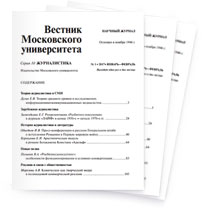Issue
№ 1
' 2017
Content:
-
Theory of Journalism and Media
«Middle Range Theories in the Research of Information and Communication Media Systems»
The article analyzes the theory and methodology of media systems research. The author considers the possibilities of studying modern media through the application of middle range theories, which will result in changes to the traditional approaches grounded in philological and historical methodologies.
Keywords: theory, methodology, information and communication media systems, middle range theoriesEvgeny Ya. Dugin 3 -
Foreign Journalism
«Representation of the Beat Generation in the Life Magazine in the Late 1950s – Early 1970s»
In the 1960s, American society underwent serious changes and became more liberal in its morals and values. In the article, this development is examined through the representation of the Beat Generation in LIFE, a general interest magazine, during two periods: 1958—62 and 1968—72. The author assumes that the media outlets with a huge readership could reflect not only the editorial opinion, but also the attitudes and values of average Americans. Therefore, by examining the changes in the media coverage of the Beat Generation it is possible to trace the changes in American society as a whole during the 1960s. A content analysis of relevant articles in the LIFE magazine showed that during this period the representation of the Beat Generation definitely shifted for the better, which affirms the liberalization of society’s morals. No researches on the media coverage of beats have been made so far, no opinion polls showing Americans’ attitude to them in the 1960s were conducted either. This suggests that the current research offers a novel approach to the studies of the 1960s in the USA.
Keywords: Beat Generation, beats, USA, LIFE, 1960s, American journalismEkaterina G. Zagvozdkina 24 -
History of Journalism
«Press Conferences in the Russian General Staff about Romania’s Entry into World War I »
The article analyzes various aspects of cooperation between the Russian General Staff and journalists on the information support of Romania’s entry into World War I on the side of the Entente. Discussing at press conferences the Russian occupation of Bukovina and the same plans for Transilvania, General Staff officers tended to push Romanian politicians into an alliance with Russia. In autumn of 1916, the Romanian army suffered a heavy defeat, after which Russian General Staff officers began to design the positive image of Romanian troops, camouflage their failures and justify the retreat of Russian troops from Romania. The unsuccessful battles in Romania clearly contributed to the aggravation of the political crisis in Russia by February 1917.
Keywords: World War I, General Staff, Russian military journalism, press conferences, RomaniaIvan V. Obedkov 40 -
«The Archetypal Model in Benjamin Constant's Novel “Adolphe”»
Novels of the Romantic period commonly contain some mythological or archetypal elements. Even in “Adolphe”, a psychological novel by B. Constant (which, at first blush, seemed to unfold in everyday life scenes) one could discern the pattern of the German medieval novelistic plot about Tannh user, the knight, who found himself in the grotto of Venus. The imminent dramatic denouement is predetermined not only by the reflecting and egocentric nature of the main character and hypocritical social attitudes but also by the subconscious mythological parallels in the entire concept of the novel.
Keywords: romanticism, B. Constant, “Adolphe”, historical poetics, archetype, German mythology, analytical psychologismElena N. Kornilova 64 -
New Media
«RosBusinessConsulting (RBC): the Aspects of Operation in the Convergent Environment»
This article discusses various aspects of how news agencies operate in the digital environment in a case study of the RBC information web service. The start of online activity, a direct access to a wider audience and the possibility of establishing a dialogue and practical interaction with the audience strengthened the position of RBC as the flagship of the media space. The article analyzes the characteristics of RBC operation from the standpoint of its status of an online business media outlet: the content structuring and heading, modification of genre forms and their elements, features of indexing, header policy and other criteria. In addition to the analysis of the web content, the author considers the news agency’s operation as a part of the media holding. The recent restart of all platforms and their integration under a single RBC 360 brand created conditions for recycling the online content in the holding’s print and audiovisual media. The analysis concludes with an evaluation of the conformity between the web service‘s convergence strategies and the audience‘s information needs and their comparison to the quantitative performance indicators.
Keywords: convergence, multimedia, news portal, media holding, business journalism, RosBusinessConsulting, recyclingVasily A. Polynov 83 -
Advertising and Public Relations
«The Comic as a Creative Modus in Polycode Commercial Advertising»
The operation of the aesthetic category of the comic is considered in the article as a way to improve the effectiveness of commercial advertising. The comic is regarded as a macro phenomenon and as one of the creative modi. The mechanism of the comic impact consists in an intellectual game, localized in one of the key components of advertising communication (in the brand or company name, in the title or in the end of the text) and realized in verbal or visual form, in naming units or narratives. The creation of game opposition and its unexpected resolution causes laughter and aesthetic enjoyment, which is normally followed by the development of a positive attitude towards the advertised product. The article describes numerous techniques of comic advertising actualized in terms of polycode means of text organization: verbal, visual, narrative and those related to objects, characters and genre.
Keywords: comic advertising, commercial advertising aesthetics, comic techniquesAnastasia V. Morozova 105







